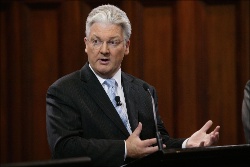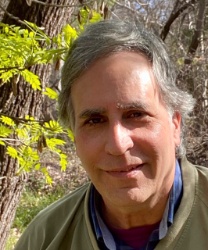Body and soul: the drive to breathe new life into NZ forests
Body and soul: the drive to breathe new life into NZ forests
by Peter Heath
July 23,
2012
Stomachs churn in unison as the chopper clears the ridge and the ground beneath us falls away to reveal a hillside cleared of the pine trees that seem to march forever through the rugged remoteness of inland Hawke’s Bay.
To our north lies the vast Te Urewera. Way over to our west Taupo and the central plateau beckon the careless and the energetic. And to our south and east the cafes and vineyards of the coast seem a world away from this rugged hinterland with its naturally-sharp contours softened by the blanket of imported pine.
“This is our latest section”, a voice crackles in my headset. “Look down there and you can see where we’ve come from.”
Looking down, I can see where the new growth juts into the forestry block – the lighter green and drab olive of young, regenerating native bush spearing into the darker coloured uniformity of the imported pine.
This is the Maungataniwha Pine Forest, a 4,000 hectare logging concession now managed by the Forest Lifeforce Restoration Trust. The Trust, established by businessman Simon Hall, helps restore threatened species of fauna and flora, and ngahere mauri (forest lifeforce), to native forests.
Just three decades ago this was mature native forest. It was logged progressively and then burned before being put under pine.
Now, in the largest and most expensive project yet undertaken by the Trust and the largest privately-funded initiative of its kind yet seen in New Zealand, the entire area is being turned back into regenerating native forest. The wheel is turning full circle.
My host, Trustee and estate manager Pete Shaw, says regenerating pine seedlings are a major challenge.
“They’re a bugger to get rid of. We try to rip them out manually but where the terrain is too difficult to get a ground team in, or where the re-growth is too dense, we have to spray them.”
It’s an expensive business - manual clearance costs around $500 a hectare, while spraying it costs $140 a hectare for the ‘brew’, the chopper hire and other equipment.
It takes two years to clear logged land of wilding pines, and a further eight to get it to full regeneration. During this time the land is nurtured, treated and monitored by Pete and his team to ensure that the species they expect to appear do so.
“We haven’t had to seed any regenerating blocks yet,” Pete said. “The native seed is in the soil, waiting. Given a chance to flourish, it does so.”
Grasses are first off the block – native species like hookgrass and toetoe. Then shrubs or small trees like mahoe and wineberry. These are followed by mountain cabbage-tree, kanuka and native fuschia. Once these species have re-colonised the land the stage is set for larger stuff such as red and silver beech.
Native birds such as kereru and silvereyes play a vital role in the regeneration process, spreading seed and propagating the land.
“Once we see these guys on the land we know the battle is half won,” Pete said.
It’s still early days. The Trust has only been reclaiming the land from pine since 2008 and Pete is characteristically cautious about claiming any great success. Yet.
“There isn’t a precedent in New Zealand for forest regeneration on this scale. This is real ground-breaking, work-it-out-as-you-go-along stuff. So there are no guarantees we’ll succeed.”
Like the regeneration effort itself, the story behind the spraying operation is a real example of ‘suck it and see’ – figuring out what works and what doesn’t. The team needed a spray formula that knocked the wilding pines on the head while giving the natives a chance to establish themselves.
“The nuclear option was never going to work for us so we worked with Lin Wilson, a former deer recovery pilot, to come up with a brew that is potent enough to knock off about 95 percent of the pine re-growth but sufficiently benign to let enough of the wild stuff take hold,” Pete explained. “Since then we’ve tweaked and refined the process to the point that we’re pretty happy we’ve got a good balance.”
The pioneering forest regeneration work being done by the Trust is mirrored in restoration projects across its four properties – three in Hawke’s Bay and one in Fiordland.
“Regeneration is about re-creating what was there in the first place; restoration is about making good the damage that’s been done to original forest,” Pete explains. “As with regeneration we’re constantly charting new territory when it comes to restoration. The learning curve is just immense.”
One such project involves Kakabeak (Clianthus maximus) - an extremely rare shrub. This is ranked ‘Nationally Critical’; there are only 90 plants known to be growing in the wild across the whole of New Zealand.
With Department of Conservation (DOC) help and permission the Trust has established a Kakabeak restoration project in the Maungataniwha Native Forest using plants located in nearby Te Urewera National Park as a source population. This involves a range of seed collection and propagation activity designed to bring the plant back from the brink of extinction.
“This, in essence, is what the Trust is about,” Pete explained. “We’re breaking new ground in the field of large-scale regeneration and restoration of privately-owned forest land – all with a view to restoring its soul. Its lifeforce.”
To this end the Trust is open to approaches by commercial and research partners wanting to use its land and resources for science and product development. It’s already working with DOC on a Whio (Blue Duck) research project, and on baiting and trapping assessment exercises. And a partnership is being explored with Lincoln University’s Centre for Wildlife Management and Conservation whereby the Trust would host many of its research projects.
As the helicopter veers towards home I’m struck by the immensity of this challenge. But with socially-aware benefactors like Simon Hall and dedicated, pioneering men and women of worth like Pete Shaw and his team, the future of collaborative, research-based, privately-funded conservation in this country is in good hands.
ENDS


 Peter Dunne: Dunne's Weekly - Little Needs To Up His Game, Otherwise Wellington's Council Circus Will Continue
Peter Dunne: Dunne's Weekly - Little Needs To Up His Game, Otherwise Wellington's Council Circus Will Continue Gordon Campbell: On Ducking The Costs Of Climate Change
Gordon Campbell: On Ducking The Costs Of Climate Change Eugene Doyle: Vive La Resistance! The Heroes Who Oppose Genocide
Eugene Doyle: Vive La Resistance! The Heroes Who Oppose Genocide Martin LeFevre - Meditations: Humans Haven’t Changed In 45,000 Years. We Can Now
Martin LeFevre - Meditations: Humans Haven’t Changed In 45,000 Years. We Can Now Gordon Campbell: On Why The Regulatory Standards Bill Is A Hot Mess
Gordon Campbell: On Why The Regulatory Standards Bill Is A Hot Mess Ian Powell: Who Benefits From Outsourcing Planned Surgery - Follow The Funding
Ian Powell: Who Benefits From Outsourcing Planned Surgery - Follow The Funding